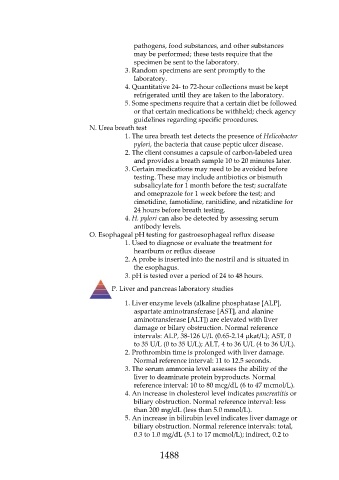Page 1488 - Saunders Comprehensive Review For NCLEX-RN
P. 1488
pathogens, food substances, and other substances
may be performed; these tests require that the
specimen be sent to the laboratory.
3. Random specimens are sent promptly to the
laboratory.
4. Quantitative 24- to 72-hour collections must be kept
refrigerated until they are taken to the laboratory.
5. Some specimens require that a certain diet be followed
or that certain medications be withheld; check agency
guidelines regarding specific procedures.
N. Urea breath test
1. The urea breath test detects the presence of Helicobacter
pylori, the bacteria that cause peptic ulcer disease.
2. The client consumes a capsule of carbon-labeled urea
and provides a breath sample 10 to 20 minutes later.
3. Certain medications may need to be avoided before
testing. These may include antibiotics or bismuth
subsalicylate for 1 month before the test; sucralfate
and omeprazole for 1 week before the test; and
cimetidine, famotidine, ranitidine, and nizatidine for
24 hours before breath testing.
4. H. pylori can also be detected by assessing serum
antibody levels.
O. Esophageal pH testing for gastroesophageal reflux disease
1. Used to diagnose or evaluate the treatment for
heartburn or reflux disease
2. A probe is inserted into the nostril and is situated in
the esophagus.
3. pH is tested over a period of 24 to 48 hours.
P. Liver and pancreas laboratory studies
1. Liver enzyme levels (alkaline phosphatase [ALP],
aspartate aminotransferase [AST], and alanine
aminotransferase [ALT]) are elevated with liver
damage or bilary obstruction. Normal reference
intervals: ALP, 38-126 U/L (0.65-2.14 µkat/L); AST, 0
to 35 U/L (0 to 35 U/L); ALT, 4 to 36 U/L (4 to 36 U/L).
2. Prothrombin time is prolonged with liver damage.
Normal reference interval: 11 to 12.5 seconds.
3. The serum ammonia level assesses the ability of the
liver to deaminate protein byproducts. Normal
reference interval: 10 to 80 mcg/dL (6 to 47 mcmol/L).
4. An increase in cholesterol level indicates pancreatitis or
biliary obstruction. Normal reference interval: less
than 200 mg/dL (less than 5.0 mmol/L).
5. An increase in bilirubin level indicates liver damage or
biliary obstruction. Normal reference intervals: total,
0.3 to 1.0 mg/dL (5.1 to 17 mcmol/L); indirect, 0.2 to
1488

